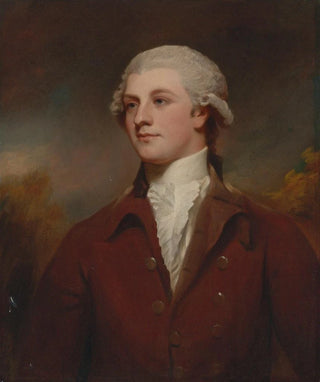Art print | Portrait of Bryan Cooke of Owston - George Romney


View from behind

Frame (optional)
Portrait of Bryan Cooke of Owston - George Romney – Captivating Introduction
In the fascinating world of 18th-century English painting, the "Portrait of Bryan Cooke of Owston" by George Romney stands out as an iconic masterpiece. This artwork captures not only the physical features of its subject but also an almost palpable essence of his personality, showcasing the artist's virtuosity. Gazing at this portrait, the viewer is transported to a time when art was one of the most refined means of communication, revealing the subtleties of human relationships and social status. The art print of this piece allows for a rediscovery of the magic of a moment frozen in time, while paying tribute to Romney's skill in immortalizing his contemporaries with such depth.
Style and uniqueness of the work
George Romney's style is distinguished by its delicate and sensitive approach to portraiture, where each brushstroke seems charged with emotion. In the "Portrait of Bryan Cooke of Owston," the artist employs a subtle palette, blending warm tones and soft shadows, thus creating an intimate atmosphere. The expression of the model, both serene and contemplative, invites the viewer to reflect on his thoughts and aspirations. The composition is carefully orchestrated, with each element arranged to direct the gaze toward the face of the subject, the true focal point of the work. This attention to detail, both in the rendering of textures and in the staging of clothing, demonstrates a technical mastery that makes Romney an essential figure of his era. He manages to transcend simple portraiture to offer a true visual narrative, where each exchanged look between the model and the observer becomes a moment of connection.
The artist and his influence
George Romney, born in 1734, established himself as one of the most sought-after portraitists of his time. Raised in a context where art was often associated with nobility and wealth, he skillfully navigated between his clients' expectations and his own artistic vision. His style, influenced by the great European masters, gradually asserted itself, incorporating elements of Romantic sensitivity that foreshadowed future artistic movements. Romney succeeded in capturing the spirit of

Matte finish

View from behind

Frame (optional)
Portrait of Bryan Cooke of Owston - George Romney – Captivating Introduction
In the fascinating world of 18th-century English painting, the "Portrait of Bryan Cooke of Owston" by George Romney stands out as an iconic masterpiece. This artwork captures not only the physical features of its subject but also an almost palpable essence of his personality, showcasing the artist's virtuosity. Gazing at this portrait, the viewer is transported to a time when art was one of the most refined means of communication, revealing the subtleties of human relationships and social status. The art print of this piece allows for a rediscovery of the magic of a moment frozen in time, while paying tribute to Romney's skill in immortalizing his contemporaries with such depth.
Style and uniqueness of the work
George Romney's style is distinguished by its delicate and sensitive approach to portraiture, where each brushstroke seems charged with emotion. In the "Portrait of Bryan Cooke of Owston," the artist employs a subtle palette, blending warm tones and soft shadows, thus creating an intimate atmosphere. The expression of the model, both serene and contemplative, invites the viewer to reflect on his thoughts and aspirations. The composition is carefully orchestrated, with each element arranged to direct the gaze toward the face of the subject, the true focal point of the work. This attention to detail, both in the rendering of textures and in the staging of clothing, demonstrates a technical mastery that makes Romney an essential figure of his era. He manages to transcend simple portraiture to offer a true visual narrative, where each exchanged look between the model and the observer becomes a moment of connection.
The artist and his influence
George Romney, born in 1734, established himself as one of the most sought-after portraitists of his time. Raised in a context where art was often associated with nobility and wealth, he skillfully navigated between his clients' expectations and his own artistic vision. His style, influenced by the great European masters, gradually asserted itself, incorporating elements of Romantic sensitivity that foreshadowed future artistic movements. Romney succeeded in capturing the spirit of






